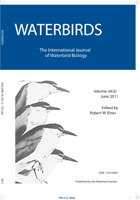The Whimbrel (Numenius phaeopus) is one of a suite of sub-arctic- and arctic-nesting shorebirds for which encroachment of woody vegetation into previously open habitats may cause a reduction in breeding habitat. Whimbrel nesting habitat selection was studied at two spatial scales near Churchill, Manitoba, Canada, to determine habitat preferences and the degree to which the species avoided woody vegetation. Whimbrels occupied sites at the mesohabitat (territory) scale characterized by either high lichen cover, or high graminoid and standing water cover. No Whimbrels nested in mesohabitat with >17.5% tall shrub cover, and only one pair nested where >38 trees existed within 30 m of the nest. At the microhabitat (nest) scale, Whimbrels nested in two distinct habitats. In lichen-dominated sites, nests had less concealing vegetation than unused sites whereas in graminoid dominated habitats, nests were more concealed than unused sites. Sixty-eight percent of nests were on hummocks or lichen ridges. Hatching success was not predicted by habitat characteristics and was lower than previously reported (2007: 26%; 2008: 14%). Avoidance of woody vegetation by breeding Whimbrels suggests that shrub and tree encroachment would reduce habitat availability in the Churchill region.
How to translate text using browser tools
1 June 2011
Nesting Habitat Selection and Hatching Success of Whimbrels Near Churchill, Manitoba, Canada
Kate Ballantyne,
Erica Nol

Waterbirds
Vol. 34 • No. 2
June 2011
Vol. 34 • No. 2
June 2011
habitat selection
hatching success
Numenius phaeopus
sub-arctic
Whimbrel




